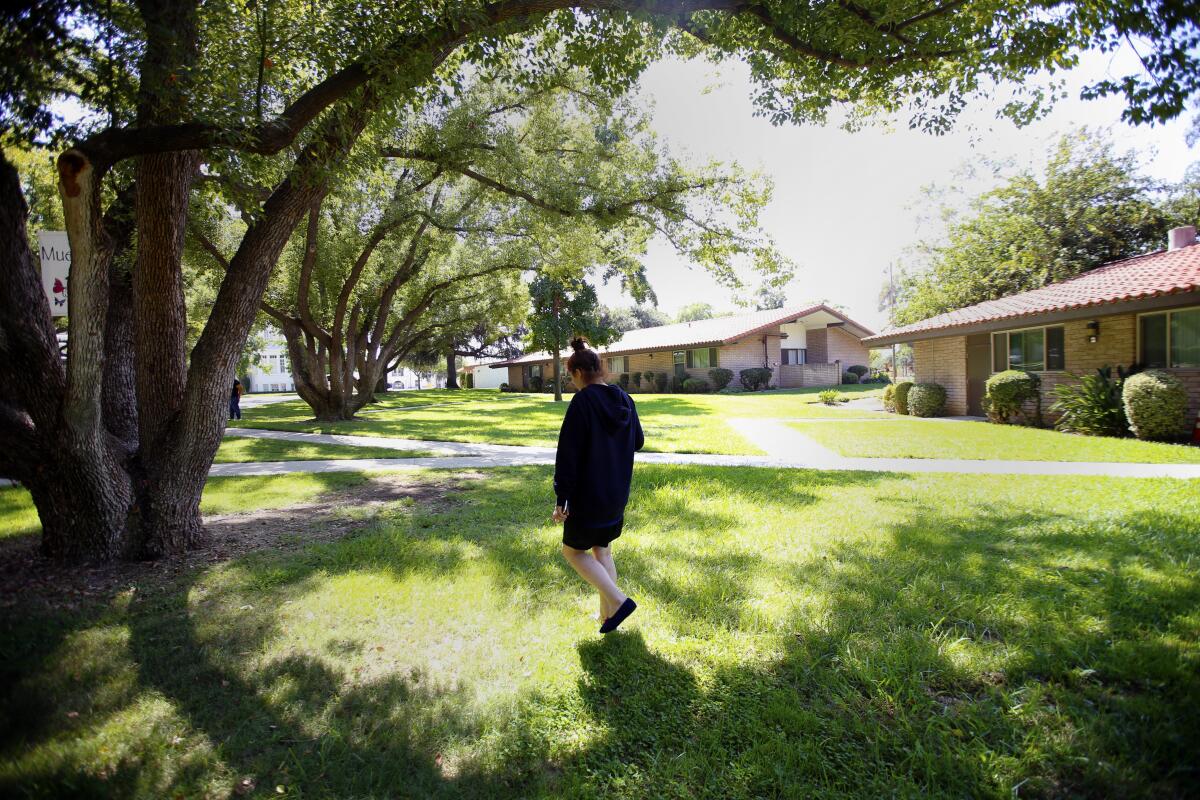A public-private model would end the foster care-to-homelessness pipeline, study suggests

- Share via
A mix of philanthropic capital and government rental subsidies could close the housing gap that leads hundreds of emancipated foster care youth into homelessness each year, according to a study commissioned by seven California charitable foundations.
A financial model depending partly on grants and partly on moderate-return investments from the more than $100 billion in endowments held by the major foundations could produce enough dedicated housing to provide stability for the 1,140 youths leaving foster care each year, the study found.
But it would not be an easy lift. Revenue to support the financing would rely on a quilt of public subsidies that currently fall short of the estimated operating costs of the housing. The difference would have to be made up by legislative enhancements or more foundation giving.
Scaling Housing to End the Foster Care to Homelessness Pipeline, released Tuesday by Genesis L.A., evaluates a financial model in which grants and investments from private foundations would eliminate the need for government capital for building, thus reducing the time and cost of construction. Government’s part would be to increase the rental subsidies and extend them longer after youths age out of the foster care system.
“Government should rely on the private sector to develop housing and then commit to covering rent in those units to house individuals through rental subsidies and longer-term lease arrangements,” the report said.
It found that every $1 in outright grants would support an additional $9 in investment, with a return of 8%. That’s the target of foundations seeking a sweet spot for investment in projects that support their philanthropic mission. Although willing to forgo double-digit market-rate returns, they still need to sustain their endowments for future grant making.
Gov. Gavin Newsom is proposing $20 million for the Court Appointed Special Advocate foster care program. Leaders of the volunteer group say they already planned for his earlier commitment of $60 million.
The streamlined financing — combined with savings from eliminating requirements for prevailing wage, parking and other amenities — would reduce the construction cost of a two-bedroom apartment unit from the $760,000 currently incurred in the publicly financed model to $540,000, or $270,000 per bedroom.
Buoyed by the finding, foster youth advocates who pushed for the study said they are encouraged to take the next step, searching for a fund manager to raise up to $750 million.
“It gives me confidence,” said Scott Koch, executive director of the Reissa Foundation, a Santa Monica organization dedicated to improving the lives of vulnerable populations. “It validated this question that we had: ‘Is it possible to take all of the tools we have in philanthropy and create an environment that can ignite investment into development of housing for foster youth at scale?’
“The report tells us it’s possible, so we should continue to push the work forward.”
Daniel Heimpel, a former journalist and blogger on foster care who turned to activism, said he was encouraged by the report’s conclusion to push forward.
“If the foundations hold together on this, they could actually significantly decrease the number of young people who wind up on our streets, which is a great contribution to our community,” Heimpel said.
The report was commissioned by the Ralph M. Parsons Foundation, Weingart Foundation, Conrad N. Hilton Foundation, Reissa Foundation, Cedars-Sinai, Specialty Family Foundation and WHH Foundation.
It took a broad look at foster youth homelessness. Based on surveys showing that 20% to 40% of the approximately 1,140 youths leaving foster care each year become homeless, it established a housing gap ranging from 684 units to 1,368.
It then examined the construction and operating costs of three types of housing that could fill that need: apartment buildings with 50 two-bedroom units, rehabbed motels and hotels, and single-family homes.
A young homeless woman found herself pregnant in 2018. Four years later, her story shows the trials and tribulations of people like her.
The apartment buildings and single-family homes would be shared living with a bedroom for each youth and common kitchen and living spaces. The rehabbed buildings would be single apartments. The report found that the apartments and single-family homes were most appropriate for youths ages 18 to 24, but both had drawbacks.
For example, many youth are better served in mixed-population buildings as opposed to living with only emancipated young people.
The report cautioned that shared housing can be successful for youth but that the youth need a say in picking roommates and cannot be required to carry occupancy costs when a roommate leaves.
“These operating needs are very difficult to achieve in the private market with private landlords and is most likely to succeed in nonprofit-owned and supported buildings or in master-lease settings,” the report said.
The goal of integrating foster youth into the general population will be a key issue in setting the size of the fund.
A $250-million fund could be sufficient to fill the highest estimated gap of 1,368 beds.
But Heimpel has his sights on a $750-million fund to produce 3,000 beds for foster youth and older and mixed-income tenants.
“If you wanted to get to 1,400 units for young people at the high end of what the report is suggesting and you consider that young people want to be in mixed income developments — they don’t want to be cordoned off — then you need a significant amount of mixed income,” Heimpel said. “You need that integrated into the plan.”
The report identified two points on which the current support for emancipated foster youth would be insufficient to support the model. First, the rental subsidy programs are generally limited to three to five years, leading to a “cliff event” that leaves many homeless.
“In reality, foster youth, like most youth, need financial support throughout their 20s to sustain safe and healthy housing,” the report found.
“We spoke with multiple frontline service providers and youth advocates who reasoned that youth need an ‘offramp’ that provides modest support for up to 10 years as youth improve their financial condition and can remain financial sufficient,” it said.
That offramp could be a subsidy that stretches as far as 10 years while gradually decreasing.
Secondly, the current subsidies are too low, leaving a gap in the 8% return model.
The report identifies several pending bills that would ameliorate those shortfalls but still posits that additional philanthropic money would be needed to sustain operating costs.
Genesis L.A. is a community development investment fund that collects capital from multiple sources to make loans to community and economic development projects. It often provides hands-on support for community developers doing alternative housing models.
Genesis President Tom De Simone said the report shows the viability of one alternative to the cumbersome government housing model.
“What we are saying is we need other pathways,” De Simone said. “That pathway alone is never going to be sufficient. We need two, three, four, five lanes. What this is trying to show is another path to go down to develop more housing.”
More to Read
Sign up for Essential California
The most important California stories and recommendations in your inbox every morning.
You may occasionally receive promotional content from the Los Angeles Times.
















